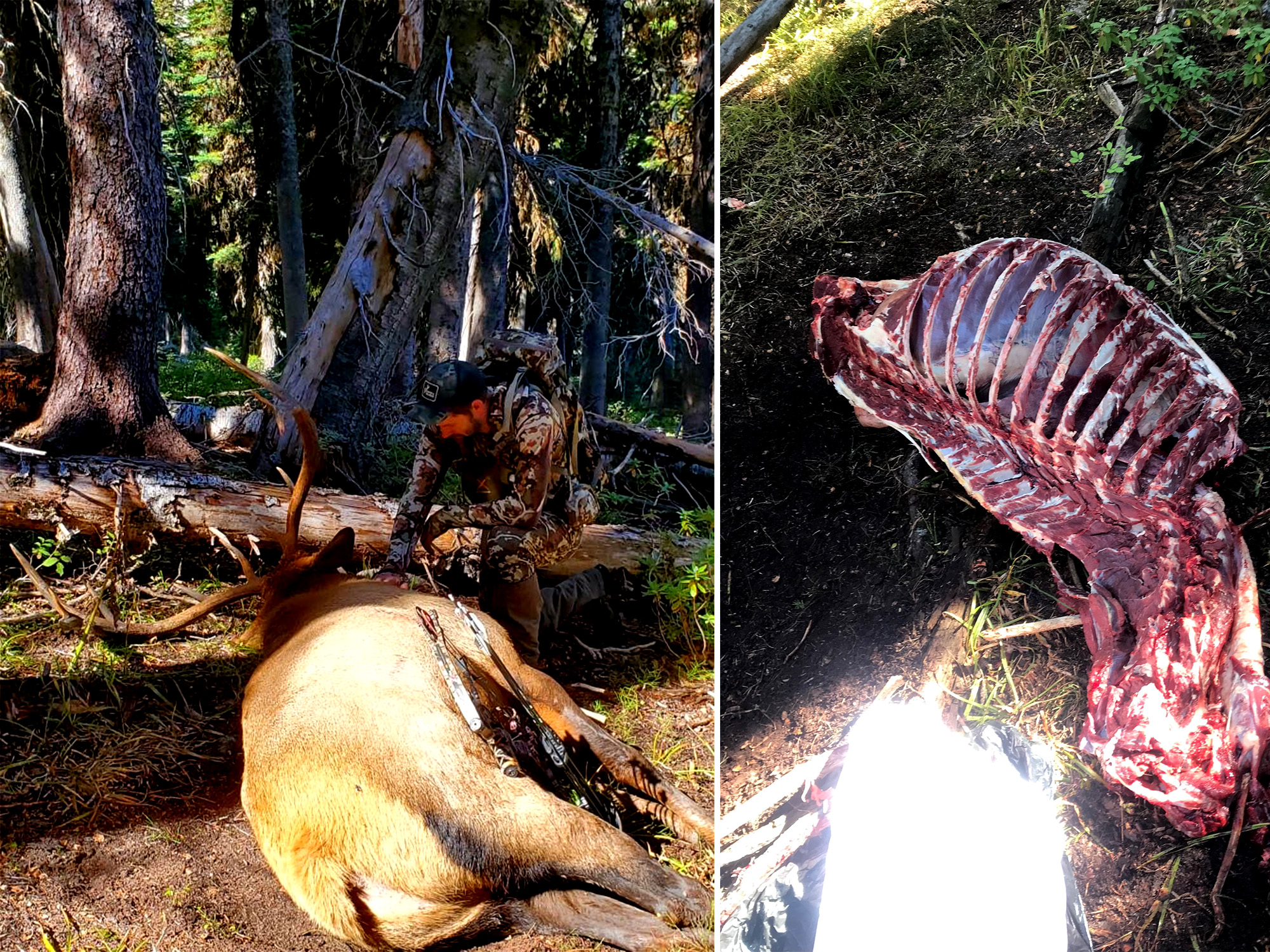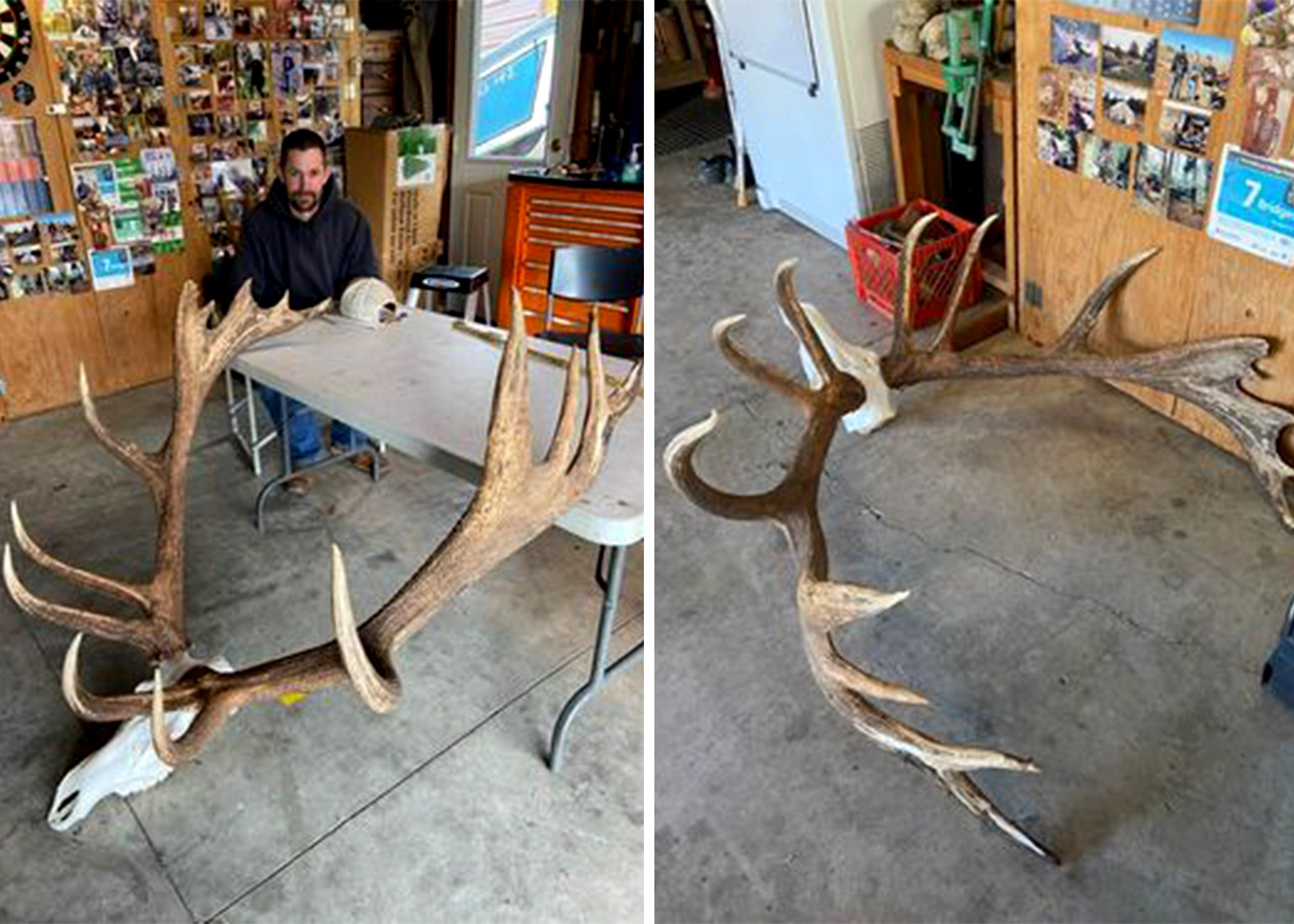It took Josh Kelsey more than two decades of hunting and a half-decade spent chasing the same bull to grasp the most important lesson of all: If you want to kill the biggest elk in the woods, you have to be the biggest elk in the woods.
The 35-year-old Oregon bowhunter tells Outdoor Life that he also learned most of what he knows now about elk hunting from the mistakes he’s made. And in the years since he and a buddy first laid eyes on Oregon’s new No. 1 Cascade Roosevelt bull, he’s made plenty of those.
“Five years ago he was a heavy 7×7. But we never even came close to shooting this animal. He was just smart and shy,” Kelsey says. “He got big for a reason. It just took us a while to figure it out.”
Roughly two years later, Kelsey changed his whole approach to elk hunting. Instead of day trips into the elk woods, he committed to three- to five-day backpacking hunts—always on public land and during the general season. This gave him the freedom and mobility he needed to understand elk on a deeper level.
“Instead of going home or back to camp every night, I had camp on my back, so I could just pick up where I left off the night before,” Kelsey explains. “That was the biggest game changer for me, because it gave me the ability to stay with the elk and live with the elk.”
It worked, and Kelsy started killing more elk. And while he slowly pieced together the habits and mannerisms of the heavy 7×7 that still roamed his home county forests, the bull always eluded him. After screwing up setup after setup, he’d go hunt a different unit and harvest another elk, and then he’d be tagged out for the season. That would give him another year to stew on the elusive bull.
“The mental side of solo hunting is just hard,” explains Kelsey, who was spending more and more time alone in the woods as he obsessed over the bull. “You miss your family and your kids, and all that jazz.”
The other mental hurdle Kelsey had to overcome was tempering his impatient nature. He doesn’t like sitting in one place, and his tendency to move in too soon often pushed the bull (or the herd) too hard. So, going into the general season archery opener on August 27, 2022, he decided to take a more patient approach.
Don’t Forget to Call Your Wife
On opening day, Kelsey hiked into the same heavily pressured unit in Jackson County, and headed straight to a spot where the big bull liked to hang out. The bull bugled that morning and let Kelsey know where he was. The elk wasn’t super vocal—he never was—but Kelsey was able to get eyes on the herd by midday. Unable to resist the opening-day temptation to move in on the bull he’d been chasing for so many years, he worked closer and checked the bull’s temperature with a challenge bugle, waking the bull from his midday nap. The big herd bull rounded up his cows and split.
Kelsey went home and licked his wounds for a couple weeks. By mid-September, he was back in the same unit with his pack on. This time, he told himself, he would actually be patient.
Read Next: On a Colorado Elk Hunt, Any Legal Bull Is a Trophy
When he returned to the same spot he’d hunted on the opener, he couldn’t locate the bull. So, he sat and waited.
“I’m thinking, okay, stick to your plan,” Kelsey says. “So, I hung out and stayed a few nights. On the third day I was able to hike to a place where I could get cell service. I was able to get [a call] out to my wife and she mentioned it was time for me to come home. And this is why I can say that I never would have killed this bull if it wasn’t for my wife.”
Sure, he agreed. He’d start heading home. It was Sept. 14, and Kelsey still had two days’ worth of food. He knew that on his way back to the truck, he’d pass one more spot where he had a decent chance of finding elk. It might not be the elk, but it was worth a look.
“So, I hit a locate bugle, and he answers—well, an elk answers. And I’m like, Hmmm…I’m supposed to be going home, what do I do? If I close the distance and I get him down, she’ll understand. Or I’ll figure it out.”
Noting the thermals, Kelsey repositioned himself on the slope and bugled again. The bull bugled right back. His temperature was getting higher.
Spooking a Record Bull
Moving slowly through the timber, Kelsey bugled again. A bull came running—all the way to within 25 yards. But the forest was so thick he couldn’t even glimpse its antlers. The bull snorted twice and turned around, working his way back to the herd. Kelsey waited 30 minutes, stalked around to keep the wind in his favor, and he attempted another locator bugle. At this point, the elk was still above him on the mountain.
“I cut the distance down and bugled again. And at this point I’m challenging him, trying to pick a fight,” Kelsey says. “This bull just doesn’t want to fight. And this is why I think he got so big. He would always bugle real low, and then push his cows farther away.”
If he had kept his vow to remain patient, this could have been the end of Kelsey’s hunt. But after so many years learning the unit, Kelsey realized he was in the perfect location to push even harder. It was after 10 a.m., and he knew the cows would want to bed soon. He also knew that the far side of the next ridge harbored a cool, damp patch of timber where they’d be inclined to stop.
Kelsey decided to try pushing them in that direction. He bugled and the herd would move off. He’d wait 10 to 15 minutes and then bugle again. He kept pushing the herd like this until early afternoon, when they reached the far side of the ridge, and he finally got a look at the bull broadside from 60 yards. The bull was massive, with long tines and a heavily palmated right antler.
“I looked, and yep, it’s really him,” Kelsey says. “This is the first time I’ve been able to see him this close. This is what I’d been working toward.”

Maybe the bull had gotten fed up with the competitor that had been dogging his harem all morning. Or maybe he was looking for stray cows. For whatever reason, he stopped retreating and walked directly toward Kelsey’s position. The bull finally got to within 50 yards and passed behind a tree, but when Kelsey drew, the bull spooked and disappeared.
Third Time’s the Charm
Kelsey was too close to turn back or sit tight now. He dropped farther down the ridge, hoping to spot the bull again. Before he knew it, he had stumbled right into the middle of the herd. Surrounded by cows and calves, he dropped to his knees and froze. Because he was supposed to be heading home, Kelsey still had his full pack on. He was hard to miss.
The boss cow stood up and barked, and he knew that whatever happened in the next 30 seconds would dictate the rest of his hunt. In that moment, he became the biggest elk in the woods.
“I was told by my elders that if you ever get in the middle of elk and that bull is hot and heavy, you have to act like a challenger,” Kelsey explains. “Chase the cows, get in the middle of them, and rip a bugle that’ll challenge the herd bull to make him defend his cows. Make him come to you.”
The bull came running, alright. Just not from the direction Kelsey had been hoping.
“Nothing happened at first,” he says. “But then I start to hear something, and sure enough, he’s coming in right behind me. I’m caught red-handed. So, I do the slow turn. I make it slow—very slow. I finally get my eyes around and could start to see an elk coming into my peripheral.”
Read Next: The Final Climb: A Steep Lesson in Elk Hunting
Kelsey looked around as the giant bull worked closer. He was able to pick out two shooting lanes: a hole in the trees at 35 yards, and another at 45 yards. As the bull walked behind a bush, he nocked an arrow and drew.
The bull was quartering away when he stepped behind the farther hole. Kelsey hit the cow call to stop the bull, anchored, and released as the pin settled.
“I shot from 47, and the arrow stayed in him at full fletch,” Kelsey says. “The bull ran a short ways, stopped, and then proceeded to walk towards the herd at the ridgetop and out of my life again.”
Only this time, Kelsey had a blood trail to follow. He knew he’d made a good shot, and after waiting a couple hours to let the bull expire, he started the recovery. Kelsey walked up on the bull roughly 800 yards from where he’d released his arrow. Then he set up camp and got to work. He didn’t make it home to his wife that night. She would just have to be patient.
A New Record-Book Bull
Notching his tag on the bull he’d nicknamed “Poppa Pig,” Kelsey closed a long and meaningful chapter in his life.
“I have a tremendous amount of respect for this animal. More than most could ever understand,” Kelsey says. “In the end, I had to keep the old man up past his bedtime, steal his woman, and ask him to fight!”

Official scorers with Pope & Young gave Kelsey’s bull a final gross score of 431 5/8 inches, and a net score of 401 2/8. The bull was also measured by scorers with NW Big Game Records, which maintains the state record books for Montana, Idaho, Oregon, and Washington. According to NWBGR’s scoring system, which is slightly different from P&Y’s, the bull received a final score of 409 3/8 inches.
This makes Kelsey’s bull not just the new No. 1 archery Cascade Roosevelt bull ever killed in Oregon, but the highest-scoring Cascade Roosevelt bull ever killed in the state–regardless of method of take.
The 7×8 bull was scored as a typical, even though it looks a lot like a non-typical. This is mainly due to the bull’s incredible mass, especially on its right beam.
“It looks like a moose on one side in some ways, so people automatically think non-typical,” Kelsey explains. “But according to their scoring systems, he scored typical for both the Oregon Book and Pope & Young.”
The P&Y entry is still pending, and Kelsey will have to wait roughly two years for a panel of scorers to officially confirm Poppa Pig’s rank. The current No. 1 typical Roosevelt bull in Oregon, according to the P&Y record book, scored 391 6/8. The current No. 1 typical Rocky Mountain bull scored 378 6/8 inches.
